ASUS UX31A: Putting the Ultra in Ultrabooks
by Jarred Walton on August 28, 2012 9:00 AM EST- Posted in
- Laptops
- Intel
- Asus
- Ivy Bridge
- Zenbook Prime
- Ultrabook
ASUS UX31A: Gaming Performance
First, let’s get this out of the way: this page is only for those who are interested/curious about gaming potential. If you’ve seen any of our previous looks at Intel’s HD 4000 GPU performance, you should already know what to expect. Intel can now run DX11 titles, but in practice you’ll need to use a lower resolution (e.g. the ever-so-popular 1366x768, or even 1280x720) with low to medium detail settings. Even then, some titles are simply too demanding for HD 4000. If you can wait another year, Haswell is supposed to double down on HD 4000 performance, but the waiting game isn’t very fun to play. We’re only going to show gaming results at our Value (~Medium 1366x768) settings, but if you want to see what happens at higher quality settings we’ve included Mainstream (~High 1600x900) results in Mobile Bench.
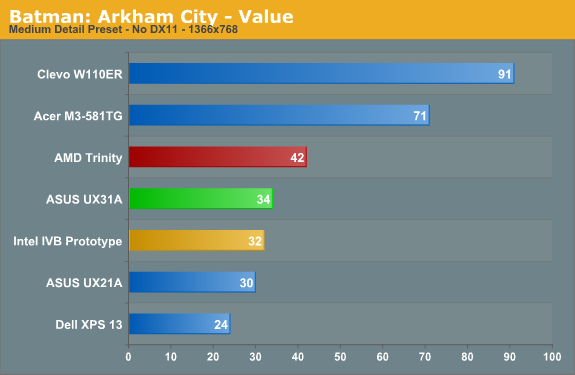
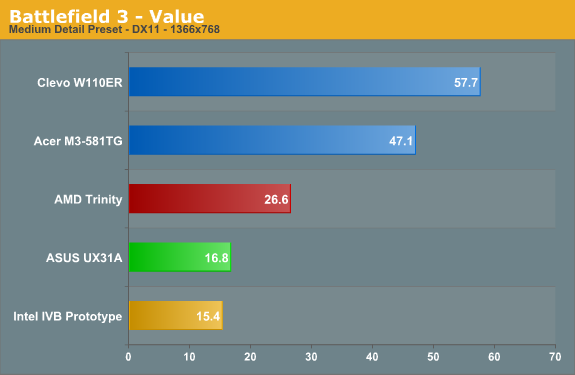
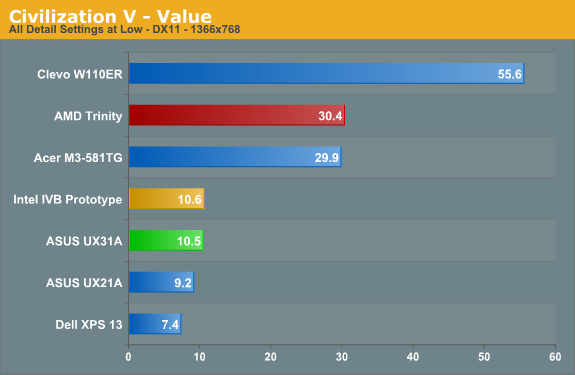
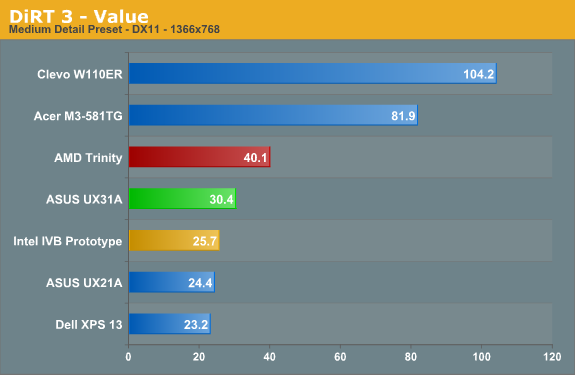
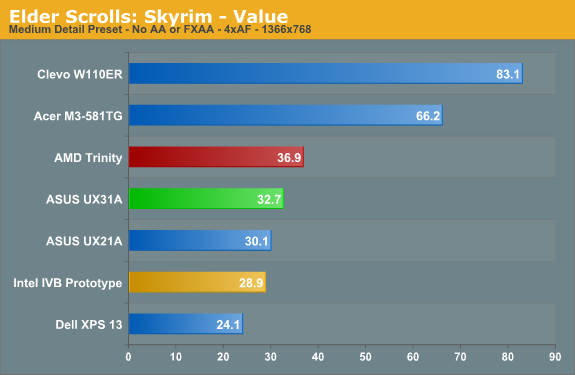

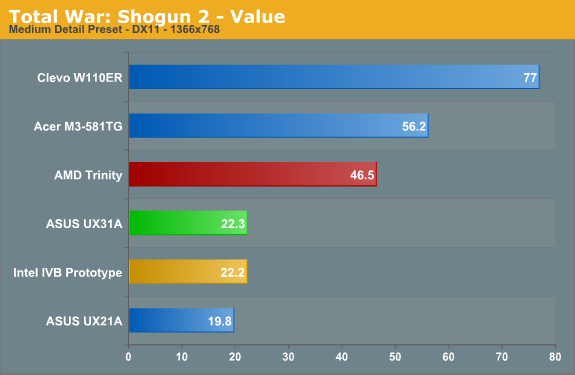
Much like the prototype IVB Ultrabook, the UX31A proves to be somewhat less capable than the standard voltage IVB parts when it comes to gaming. We still manage to pull playable frame rates in Batman, DiRT 3, Portal 2, and Skyrim, but even with average frame rates above 30FPS you’ll still see occasional dips into the low 20s or even the teens. At the native 1080p resolution, only Portal 2 is able to stay above 30FPS average, but I don’t think anyone really expected 1080p gaming to be a priority. In short, it’s possible to play some games on an Ultrabook without a dedicated GPU, but the experience won’t be all that great in many recent titles. AMD's Trinity on the other hand puts in a very respectible showing, with the understanding that the Acer M3 (and the newer M5) pretty much beat the A10 on all fronts.
At this point, we probably won't bother returning to look at Ultrabook gaming performance until something changes on the IGP (other than for discrete GPU models). We've exhaustively tested IVB ULV twice now, and the results are largely the same, other than a few minor differences that we can chalk up to drivers. If you want to know how Core i5/i7 ULV Ivy Bridge perform, the results above should tell you everything you need to know.










106 Comments
View All Comments
sheh - Tuesday, August 28, 2012 - link
It looks like the higher monitor DPI trend really started. I hope. Now just double the physical size (well, maybe stick to 24"), keep the DPI, change the ratio to 1.6, and you have a nice desktop monitor.Oh, and make it OLED. :)
bji - Tuesday, August 28, 2012 - link
Yes, and don't forget ditching 16:9 and going back to 16:10, a much more useful aspect ratio for computing.kezeka - Tuesday, August 28, 2012 - link
a 1.6 ratio is 16:10.MamiyaOtaru - Sunday, September 9, 2012 - link
I am never throwing out my 4:3 monitor. I even liked 5:4. With so many people saying widescreen is better, complaints about 16:9 make me happy inside. Reap what you sowpeterfares - Sunday, September 9, 2012 - link
No one who knows anything likes 16:9, it's too wide for a computer. I like large 16:10 2560x1600 monitors where you can have two windows open side by side with plenty of room in each window.misiu_mp - Tuesday, September 11, 2012 - link
I hate widescreen. It belongs in the living room, not on the desktop, where it is a complete waste of pixels.I miss 1600x1200 displays. For laptops I find the 1400x1050 very comfortable at 15''. Alas, the mass hysteria of "wide-screen", "HD" combined with the popularization of consumer electronics made really useful screen sizes a niche that no one dares fill up. Shame.
magreen - Tuesday, August 28, 2012 - link
This. A million times, this.pkaro - Tuesday, August 28, 2012 - link
It's a 25% reduction in weight.Change = (Initial - Final)/(Initial) * 100
JarredWalton - Tuesday, August 28, 2012 - link
Fixed, thanks.MichaelD - Tuesday, August 28, 2012 - link
Nice review! Very detailed and I enjoy your personalized writing style. Thanks, Jarred.IMO, the Ultrabooks are getting there. I don't at all care for proprietary connectors on the storage and *ugh* soldered-on memory, but the form factor is nice and thankfully we FINALLY have decent screens on laptops. When I can get an ultrabook with at least 16x9 res, user upgradable memory and standard form-factor (SSD) storage for under $1K, I'll bite.